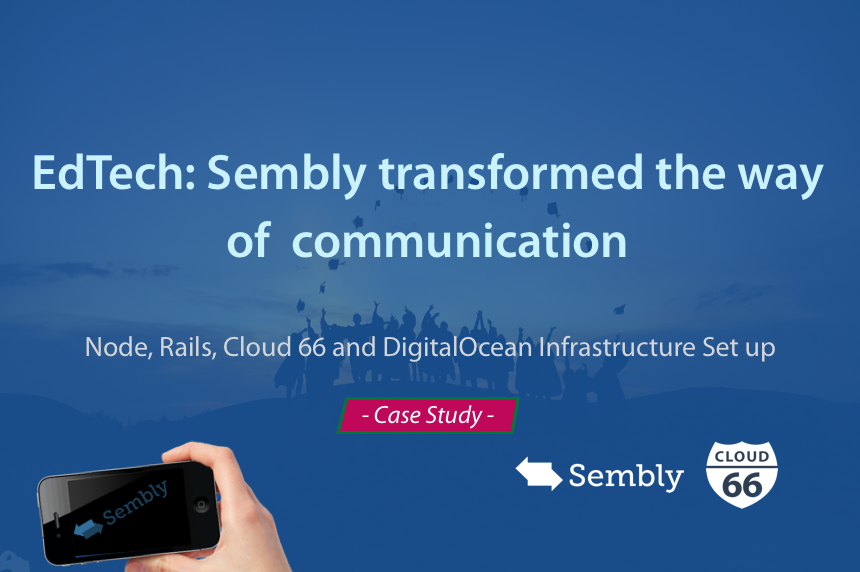This Case Study features Sembly, an audience response system for colleges, universities and conferences. It covers the details of Sembly’s infrastructure setup, which includes the use of timetables API, Cloud 66 for Rails and DigitalOcean.

To find out more about EdTech (education technology) I got in touch with Nadeem Qureshi, the CEO of a Norway-based startup, Sembly. We talked about how Sembly transformed students and teachers communication experiences and I asked Nadeem to share his story of working with Cloud 66.
Sembly Background
We have all been at lectures or a conference where the presenter asks: do you have any questions? You do, but decide to not to ask because there is a big audience and your question might not be important enough, or you don't want to sound stupid.
This frustrated Nadeem when he was a student. He looked around to see if there is anything on the market that can solve the problem, and he found a few apps that could help. However when he approached his lectures with the idea? He found out that none of them work well in the university environment, and this is when Nadeem decided to create Sembly.
Nadeem is a self-taught developer who created a fantastic startup, Sembly with the help of Cloud 66.
What's Sembly? Sembly removes the communication barriers between the presenters and their audience by offering an extremely simple, real-time response system that is perfect for colleges, universities and conferences.
How does it work? The app is synced with the university or conference timetable. This means no setup! It instantly recognize the student and professor via registration email.
It provides a chat room that is visible to you, your co-students and professor. It allows asking questions and answers in real-time, by anyone. Additionally, the presenters can create check-points where he can ask a question to see if everyone is following what he is saying, before moving to the next part.
Now, let's ask Nadeem how Sembly works under-the-hood and how they manage their infrastructure setup?
What was your journey to Cloud 66 and how was the migration process?
Like most of the startups, I started from Heroku, but it didn't work that well. I felt like I had no control over my own app, it was slow and was getting expensive. I decided to move away from Heroku and build my own infrastructure with my own VPS server on DigitalOcean. It worked well, but was time-consuming, which is not ideal for the CEO. Then I read about Cloud 66 in Ruby weekly and decided to try it out. It turned out it was a perfect solution for Sembly.
The migration process was pretty straight forward. After signing up for a Cloud 66 account and giving them access to the git repository my app was up and running within minutes. It was fantastic news that I could still deploy to DigitalOcean. Deployment to any cloud or any server gives a great flexibility. Now, it's nearly three years that I've been running my servers with Cloud 66 and the deployment never went down, in fact, "Cloud 66 does such a good job, I don't need to think about it. It just works". :)
Sembly app, infrastructure set up
I am a self-taught developer, which means that I learn as I get further into the project. We started Sembly infrastructure from Rails app, then we moved to Jango and ended up with Meteor, Node app.
Currently, we use Cloud 66 for Rails to handle our API's. This is a crucial part of our infrastructure as it syncs all the different timetables used by the universities and conferences with our application. It also helps us to identify the user with the university, and with the course they are attending.
Sembly's public facing app is written in Node, Meteor and runs on Meteor Galaxy. It works well, but we are missing the github support, the ease of scaling and the flexibility of choosing our own cloud provider, therefore we are super excited about the recent release of Cloud 66 for Node!
What are your favorite features
Due to the nature of our application, we found that the cron job facilities are very useful for us. It helps us sync the timetables with our app frequently, so our users don't experience any timeouts.
Another very useful feature is Cloud 66 backups, we love the new binary backups feature. That offers us a seamless backup experience with our MySQL database and allows us to move our entire stack from one server to another or one data center or cloud to another one.
Lastly, due to our daily growth (we have over 100 new signups every day), we want to make sure that all our users have the same, great experience, and therefore scaling comes in very handy. We like the flexibility with the 'scale as you need it' option.
What are your plans for the next 6-12 months?
The road map for Sembly focuses on expanding, getting more students and universities to start benefiting from our application. To support our growth we are currently working on the English version of the application.
Thank you Sembly!
We're delighted to work with the awesome folks at Sembly. It was great to find out more about EdTech and how Sembly's fabulous product improves student lives. I would like to thank Nadeem for finding the time in his super busy schedule to chat about Sembly Rails and Node set up and how it fits with Cloud 66 services.
